Sometimes, luck and happenstance can have a beautiful result. Such is the case with the saucer magnolia. This hybrid specimen was created by retired French cavalry officer Etienne Soulange Bodin, and it quickly became the centerpiece of gardens across the world.
Also called Chinese magnolia, Japanese magnolia, or magnolia tulip, the saucer magnolia can be found in landscapes across the Southeast, the eastern seaboard, and parts of the West Coast.
Its refined elegance and delicately colored flowers bring to mind the Orient and old-world gentility. With majestic flowers that come in various shades of white, pink, and purple, appealing leaves, and attractive fall coloring, this beautiful small tree is an attractive addition to any property. As a bonus, it is easy to control the size and spread.
With over 100 varieties that differ in flower shape, size, bloom time, and coloring, you are sure to find a specimen you can’t wait to add to your yard.
To ensure your trees and plants don’t compete for nutrients, make sure to identify and remove weeds from your property. We have a guide on weed identification that includes photos.
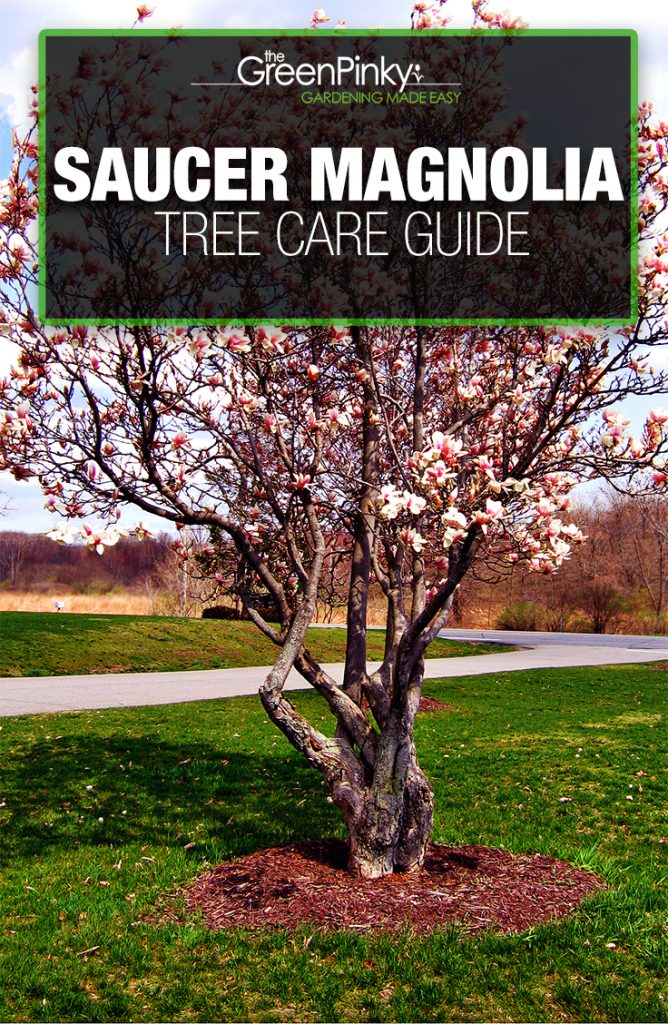
General Information
The saucer magnolia (Magnolia x soulangeana) can be cultivated as a shrub or small tree. The trunk is covered by smooth, silvery-gray bark and grows to a mature height between 20 and 30 feet and a spread between 15 and 25 feet. This compact size, along with its ideal spread-to-height ratio, makes it a fantastic addition to any landscape.
The large cup-shaped flowers appear as early as February and bloom through April. The tree can reflower in the summer and winter, albeit in duller hues. The flowers are 4 to 8 inches wide and bloom in different shades of white intermixed with pink and rose-purple tones. The flower’s resemblance to a teacup and saucer inspired the plant’s common name.
The plant’s dark green leaves are simple and grow alternately on stout stems and branches. They have an oval shape with smooth edges that come to a pointed tip. The upper surface looks glossy, while the underside is fuzzy. The leaves grow to be 3 to 8 inches long and 4 to 10 inches wide. The leaves appear after the flowers have bloomed and stay on the branch through fall.
Seeing the white-pink flowers of the saucer magnolia blooming on its bare, multi-stemmed branches before the leaves appear is truly a sight to behold.

Care Guide
Sunlight Requirements
This plant prefers full sun conditions. It does best if it receives at least 6 hours of direct, unfiltered sunlight each day. While partial sun (4 to 6 hours of direct sunlight) and partial shade (2 to 4 hours of direct sunlight) aren’t ideal, they aren’t a deal-breaker. The shrub can potentially survive with as little as 2 hours of direct sun.
In places with harsh winters, you’ll need to protect the tree with a wrap for the first years of its life. In these areas, you should avoid planting on southern exposures, as this causes the flowers to bloom too early in the year. All it takes is one frosty night for the flowers to turn brown and their beauty to be spoiled.
Soil Conditions
The saucer magnolia can grow in soils that range from sand to loam to clay. However, its ideal soil is loamy, stays damp, and drains well. The tree prefers a slightly acidic pH level between 5.5 and 6.5. It fares best in nutrient-dense and organically rich porous soil. The plant does not do well in dry or alkaline soil.
The shallow-growing root system doesn’t usually grow deeper than 16 inches into the soil. The roots are rope-like and thick and grow unbranched horizontally for moderate distances. To maintain the soil’s moisture level and temperature, spread mulch over the root zone around the base of the trunk. Allow for 1 to 2 inches of room between the base of the tree and the mulch. This will support healthy, virile growth.
Make sure to also check out our popular guide on how to plan out and start a garden.
Water Requirements
The saucer magnolia has three different phases of life. Each requires a different watering technique.
Immediately After Planting
Once you have planted the tree, saturate the soil and the young roots. Don’t worry about overwatering the tree at this point. The moisture is needed to support the shallow root system’s establishment.
Once you are beyond the initial watering sessions, ensure that the soil remains moist but not soggy. Soggy soil will drown the young roots, while dry soil will weaken their growth. You need to find the happy medium.
While the Tree Is Establishing Itself
As the roots establish themselves, you must ensure that the soil stays moist. This is especially important if they are not receiving sufficient irrigation from the environment. Infrequent watering sessions that soak deep into the soil encourage the roots to grow deep into the soil, rather than just along the surface. Deep roots are important to anchor the tree to the ground so that heavy winds are less likely to knock it over. Before the root zone has spread very far, water the tree for 20 minutes by placing the hose on the ground next to the base of the tree. This technique will allow the water to soak deep into the soil.
Keep up these deep, infrequent watering sessions for the first 3 years of the tree’s life.
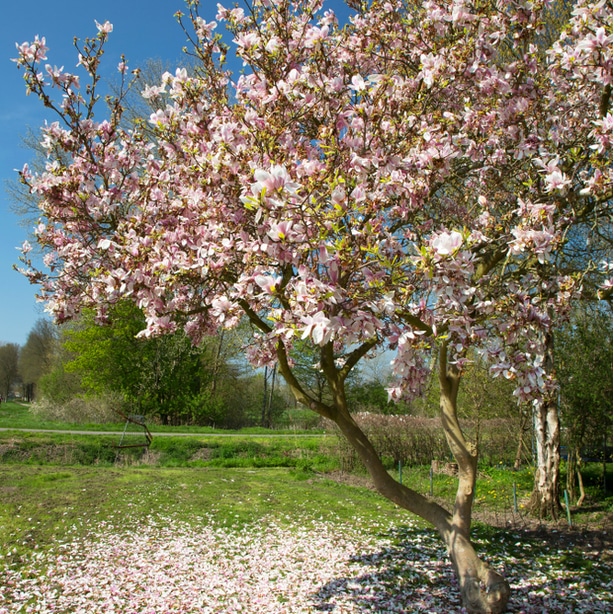
After the Roots Are Established
Deep, infrequent watering is still important once the roots have anchored the tree into the soil.
When the air temperature dips below 70℉, check the moisture level of the soil by hand. If the soil is dry, water your saucer magnolia deeply for 20 to 30 minutes. The tree needs 2 to 3 gallons of water for every inch of its trunk diameter.
When temperatures are between 70℉ and 80℉, water once a week for 20 to 30 minutes. Water twice a week when temperatures are between 80℉ and 90℉. When temperatures soar above 90℉, water the saucer magnolia 3 times a week.
Protecting Established Trees
Once the tree is firmly established, use the soil consistency to determine your exact watering schedule. Sandy soil drains faster than dense, clay soil. So, sandy soil will require more frequent watering for less time. Clay soil is just the opposite and needs less frequent watering and longer sessions.
To determine how far the root zone extends from the base, add one foot for every inch of trunk diameter. For example, 6 inches of trunk diameter equals a 6-foot radius around the tree.
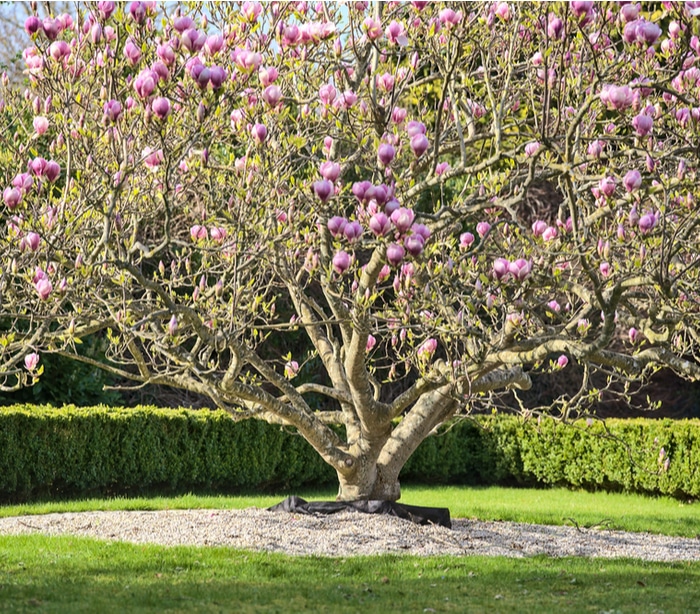
Fertilization
You should only fertilize your magnolia if it shows signs of weakened growth. This is characterized by a yearly growth rate of fewer than 6 inches or progressively smaller leaves with each new growing season.
Most cultivars are deciduous, so fertilization should be done after the leaves fall and before the soil temperature drops below 50℉. During these conditions, the soil will readily absorb the nutrients from the fertilizer. The roots store the nutrients through its dormancy and release a floodgate of nutrition once it’s over. A second application of fertilizer can be made before any new growth appears in the spring.
Nitrogen is an essential nutrient for the magnolia’s healthy growth and vibrant color. It also nourishes the root system. So, choose a slow-release nitrogen-rich fertilizer with an NPK ratio of 12-4-8 or 20-5-10.
A very general guideline is to use 1/10 of a pound of fertilizer for every inch of trunk diameter. For example, 5 inches of trunk diameter equals half a pound of fertilizer. After evenly distributing the product over the root zone, immediately water it in.
Keep in mind, though, that if the soil in your area is compact or drains poorly, watering in the fertilizer will result in nutrient runoff. In this case, you need to deep-feed the roots. Bore evenly spread holes into the root zone 4 to 6 inches deep. There should be 5 holes for every inch of trunk diameter. For example, 5 inches diameter equals 25 evenly spaced holes. Evenly distribute the fertilizer into the holes and water lightly.
Remember that the roots are sensitive and can be damaged by overfertilization. Overfertilization manifests itself in leaves with brown discoloration and a burnt appearance.
If you notice yellowing leaves, the soil might have a high salt content from residual fertilizer build-up. In this case, flush the roots with water to wash the salt deeper into the ground.
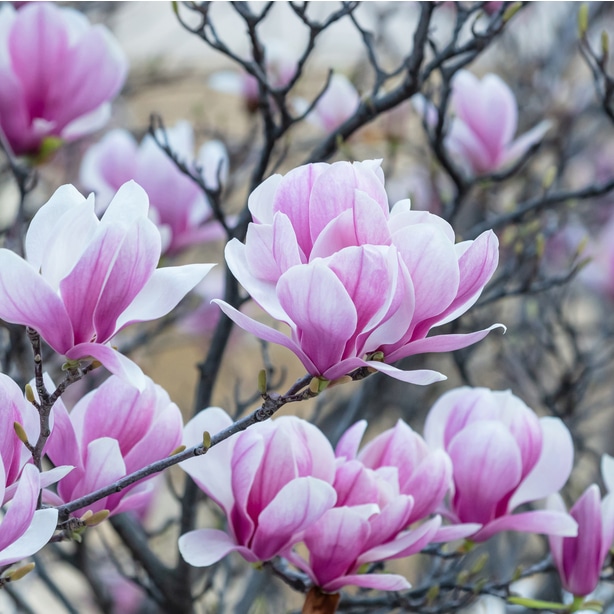
Growing Tips
Here’s some advice for growing beautiful and thriving saucer magnolias.
Planting
It is important to plant the trees correctly to give them a great start.
- If the root ball is covered with burlap or a similar material, remove it and make four evenly spaced slices down the length of the root ball 1 inch deep. This will prevent tangled roots from impeding the horizontal spread of the root system.
- Dig a hole 1.5 to 2 times wider than the root ball.
- Dig the hole deep enough that the uppermost root is at ground level. In clay soils, allow 15% to 20% of root ball surface exposure.
- Backfill the hole halfway, saturate with plenty of water, and backfill until full. Pat the soil to give it some structure while still allowing for the free flow of nutrients.
- Cover the exposed root ball with mulch if you choose. Don’t cover it with soil.
- If you plant more than one tree, allow 15 to 25 feet between specimens.
Pests and Disease
Pests and disease aren’t usually an issue for the saucer magnolia. Two fungal infections that can occur are cankers and leaf spots. Use a copper-based fungicide before they become a problem.
If you are too late and the damage is done, prune back bark cankers and thoroughly disinfect your pruning shears to avoid the fungi’s transference to healthy plants.
The saucer magnolia is wildlife resistant (except for birds) and pollution tolerant.

Pruning
You have to decide whether you want the saucer magnolia to be a tree or a shrub in your landscape.
If you would like a tree, you must shape the plant with a stake kit to ensure that it grows upward and not outward. Stake the tree while it is still young and pliable. A more mature tree’s growth habit is harder to influence.
The multitude of branches forms the rounded crown naturally. Very little pruning will be necessary.
Keep an eye out for diseased, damaged, and dying limbs and prune them immediately. If you’re just shaping the tree, do so after the flowering period has passed. Prune the tree when the humidity is low so that there is less fungal activity to worry about.

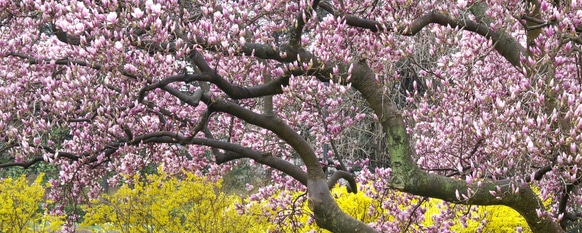
My tree is 3 years old, it’s blooming heavily now in July and the buds are looking burnt and not opening up. These are not in direct sun all day but do get 4-6 hours of sun.
Other than that it’s growing, keeping its leaves and looks great. Any ideas?